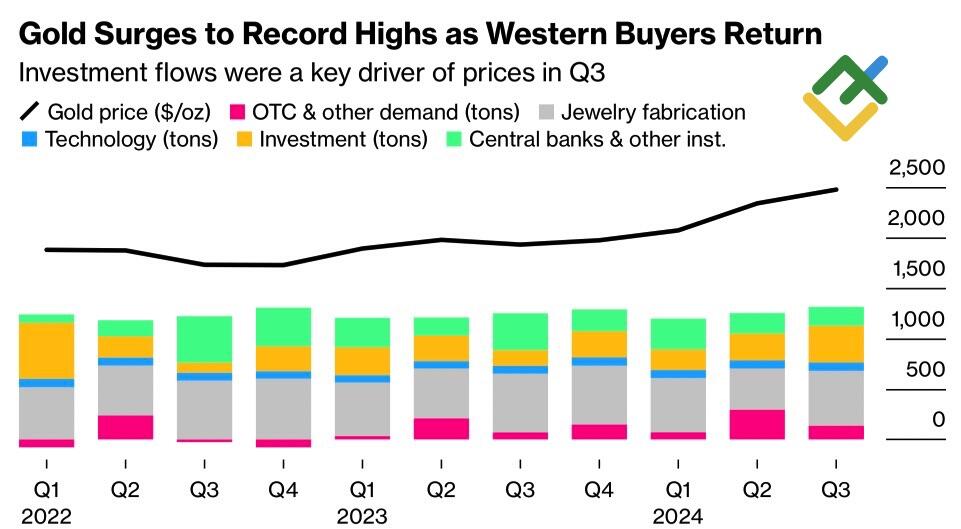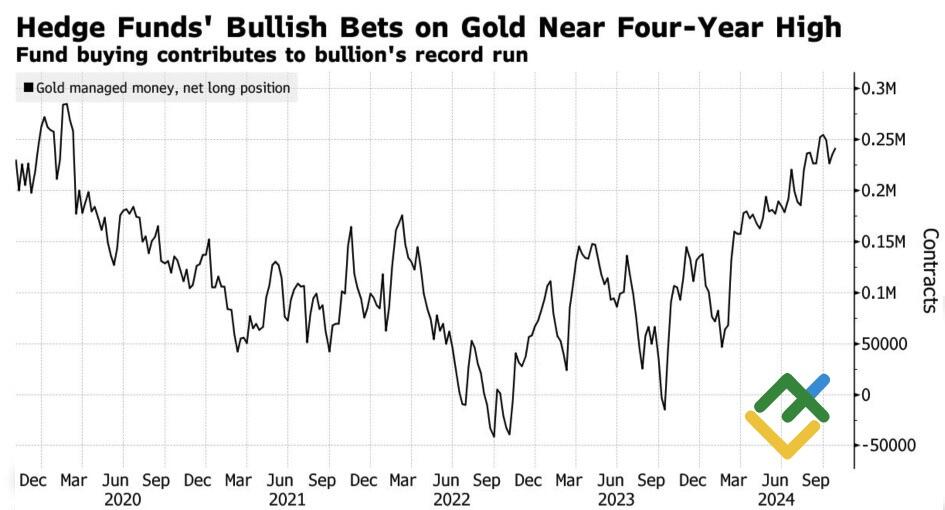
From a fundamental perspective, gold’s streak of all-time highs had solid grounds. However, many of XAUUSD‘s tailwinds are no longer as effective as they were. Will this be a reason for the precious metal to start a correction? Let’s discuss this topic and make a trading plan.
The article covers the following subjects:
Highlights and key points
- Demand for gold in the third quarter has hit record highs.
- Investment appetite more than doubled.
- XAUUSD correction risks due to the election results are high.
- Gold may slide to $2,710, $2,685, and $2,635 per ounce in the short term.
Weekly fundamental forecast for gold
In light of dovish central banks and robust demand, the pivotal question for markets is the extent to which they have become vulnerable. This is particularly relevant for stock indices and gold, which have historically exhibited a strong correlation. A decline in the S&P 500 index following disappointing corporate reports from the Magnificent Seven was the primary driver behind the XAUUSD‘s decline. Even the weak US employment figures for October did not provide a boost.
Gold has experienced an 11-month rally and an 8-month winning streak, the latter of which is the longest in its history. During that period, XAUUSD quotes have risen 33.9%, largely due to record-high demand. In the third quarter, it surpassed 1,313 tons and $100 billion for the first time. According to WGC data, interest in investment more than doubled in July-September, with capital inflows into ETFs reaching 94 tons.
Breakdown of demand for gold
Source: Bloomberg.
Gold benefited from a number of favorable factors, including the misguided appetite of central banks and the associated de-dollarization, significant monetary expansion, and even the Trump trade. However, as the XAUUSD quotes rise, investors are becoming increasingly concerned about the potential for a reversal of the “buy the rumor, sell the news” strategy. Furthermore, the strength of the previously relied-upon factors supporting the precious metal is beginning to raise doubts.
For instance, the WGC reports a 149% decline in gold purchases by central banks during the third quarter, reaching 186 tons, the lowest level in two years. Russia’s proposal to develop an alternative payment system independent of the US dollar received a tepid response from BRICS. Concurrently, the decline in Donald Trump’s ratings ahead of the election prompted some speculators to close their long positions on the precious metal.
Speculative positions on gold
Source: Bloomberg.
A report from Deutsche Bank suggests that if Kamala Harris wins the US presidential election, the XAUUSD will initially decline. However, the markets will quickly stabilize. The Fed’s monetary policy easing cycle will return to the forefront of investors’ attention, allowing gold to recover.
The return of Donald Trump to the White House may also result in a sell-off for the precious metal due to the “buy the rumor, sell the news” principle. However, uncertain election results could lead to increased demand for safe-haven assets.
Weekly trading plan for gold
Whoever comes to power in the US, the next administration will likely pursue fiscal policies that result in an expansion of the budget deficit and government debt. This, combined with the growing risks of default, is likely to create a favorable environment for gold. Given these conditions, consider purchasing the precious metal at $2,710, $2,685, or $2,635 per ounce for medium- and long-term investments. The short-term outlook for the XAUUSD will depend on the potential for a significant decline in the S&P 500 index and related sales to maintain margin requirements on shares.
Price chart of XAUUSD in real time mode
The content of this article reflects the author’s opinion and does not necessarily reflect the official position of LiteFinance. The material published on this page is provided for informational purposes only and should not be considered as the provision of investment advice for the purposes of Directive 2004/39/EC.
{{value}} ( {{count}} {{title}} )
This post is originally published on LITEFINANCE.






